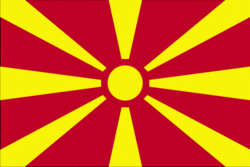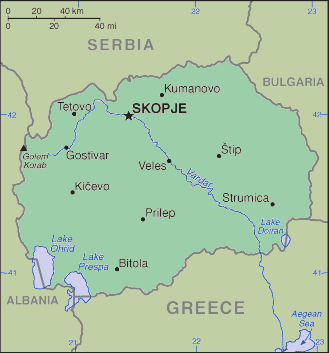Traveling Luck for FYR Macedonia. FYR Macedonia, Europe
Macedonia is located in Southeastern Europe, north of Greece.
Land in Macedonia is mountainous territory covered with deep basins and valleys; three large lakes, each divided by a frontier line; country bisected by the Vardar River.
Macedonian land covers an area of 25333 square kilometers which is slightly larger than Vermont
FYR Macedonia has borders with Albania for 151km, Bulgaria for 148km and Greece for 246km.
 Macedonian national flag (Flag of FYR Macedonia)
Macedonian national flag (Flag of FYR Macedonia)
As for the Macedonian climate; warm, dry summers and autumns; relatively cold winters with heavy snowfall.
Macedonian(s) speak Macedonian 66.5%, Albanian 25.1%, Turkish 3.5%, Roma 1.9%, Serbian 1.2%, other 1.8% (2002 census).
Places of note in FYR Macedonia
 Macedonian map
Macedonian map
Regions of FYR Macedonia
- Aračinovo
- Bač
- Belčišta
- Berovo
- Bistrica
- Bitola
- Blatec
- Bogdanci
- Bogomila
- Bogovinje
- Bosilovo
- Brvenica
- Čair
- Capari
- Čaška
- Čegrana
- Centar
- Centar Župa
- Češinovo
- Čučer-Sandevo
- Debar
- Delčevo
- Delogoždi
- Demir Hisar
- Demir Kapija
- Dobruševo
- Dolna Banjica
- Dolneni
- Ðorče Petrov
- Drugovo
- Džepčište
- Gazi Baba
- Gevgelija
- Gostivar
- Gradsko
- Ilinden
- Izvor
- Jegunovce
- Kamenjane
- Karbinci
- Karpoš
- Kavadarci
- Kičevo
- Kisela Voda
- Klečevce
- Kočani
- Konče
- Kondovo
- Konopište
- Kosel
- Kratovo
- Kriva Palanka
- Krivogaštani
- Kruševo
- Kukliš
- Kukurečani
- Kumanovo
- Labuništa
- Lipkovo
- Lozovo
- Lukovo
- Macedonia, The Former Yugoslav Republic of (general)
- Makedonska Kamenica
- Makedonski Brod
- Mavrovi Anovi
- Mešeišta
- Miravci
- Mogila
- Murtino
- Negotino
- Negotino-Pološko
- Novaci
- Novo Selo
- Obleševo
- Ohrid
- Orašac
- Orizari
- Oslomej
- Pehčevo
- Petrovec
- Plasnica
- Podareš
- Prilep
- Probištip
- Radoviš
- Rankovce
- Resen
- Rosoman
- Rostuša
- Samokov
- Saraj
- Šipkovica
- Sopište
- Sopotnica
- Srbinovo
- Staravina
- Star Dojran
- Staro Nagoričane
- Štip
- Struga
- Strumica
- Studeničani
- Šuto Orizari
- Sveti Nikole
- Tearce
- Tetovo
- Topolčani
- Valandovo
- Vasilevo
- Veles
- Velešta
- Vevčani
- Vinica
- Vitolište
- Vraneštica
- Vrapčište
- Vratnica
- Vrutok
- Zajas
- Zelenikovo
- Želino
- Žitoše
- Zletovo
- Zrnovci
Macedonia gained its independence peacefully from Yugoslavia in 1991, but Greece's objection to the new state's use of what it considered a Hellenic name and symbols delayed international recognition, which occurred under the provisional designation of the "Former Yugoslav Republic of Macedonia." In 1995, Greece lifted a 20-month trade embargo and the two countries agreed to normalize relations, although differences over Macedonia's name remain. The undetermined status of neighboring Kosovo, implementation of the Framework Agreement - which ended the 2001 ethnic Albanian armed insurgency - and a weak economy continue to be challenges for Macedonia.
At independence in September 1991, Macedonia was the least developed of the Yugoslav republics, producing a mere 5% of the total federal output of goods and services. The collapse of Yugoslavia ended transfer payments from the central government and eliminated advantages from inclusion in a de facto free trade area. An absence of infrastructure, UN sanctions on the downsized Yugoslavia, one of its largest markets, and a Greek economic embargo over a dispute about the country's constitutional name and flag hindered economic growth until 1996. GDP subsequently rose each year through 2000. However, the leadership's commitment to economic reform, free trade, and regional integration was undermined by the ethnic Albanian insurgency of 2001. The economy shrank 4.5% because of decreased trade, intermittent border closures, increased deficit spending on security needs, and investor uncertainty. Growth barely recovered in 2002 to 0.9%, then rose by 3.4% in 2003, 4.1% in 2004, and 3.7% in 2005. Macedonia has maintained macroeconomic stability with low inflation, but it has lagged the region in attracting foreign investment and job growth has been anemic. Macedonia has an extensive grey market, estimated to be more than 20 percent of GDP, that falls outside official statistics.
Macedonian natural resources include low-grade iron ore, copper, lead, zinc, chromite, manganese, nickel, tungsten, gold, silver, asbestos, gypsum, timber, arable land
landlocked; major transportation corridor from Western and Central Europe to Aegean Sea and Southern Europe to Western Europe
Macedonian religion is Macedonian Orthodox 64.7%, other Christian 0.37%, Muslim 33.3%, other and unspecified 1.63% (2002 census).
Natural hazards in Macedonia include high seismic risks.

 Search
Search FYR Macedonia country profile
FYR Macedonia country profile